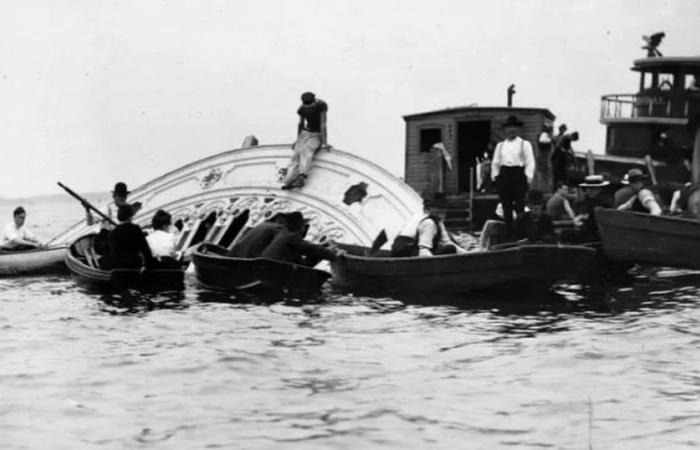
The spring day was emerging as an ideal setting for the party that everyone was waiting for, the annual picnic of the St. Mark’s Lutheran Church of the Lower East Side, which that Wednesday, June 15, 1904, had as an additional attraction a walk along the East River to Long Island aboard the paddle steamer General Slocum. Therefore, from early in the morning, 1,358 members of the German community in New York – mostly teachers, mothers and Sunday school students – boarded the ship full of expectations, without imagining that shortly after they would become protagonists of the worst tragedy in the history of world navigation before the sinking of the Titanic.
The Church had made the effort to pay 350 dollars – a high sum for the time – for the exclusive rental of General Slocum and thus give joy to the boys, who toured and observed in fascination the three floors of the wooden steamer, which was under the command of Captain William Van Schaick and had a crew of 29 men. When she set sail, at 9 in the morning, the ship was packed with children, watched by parents and teachers.

According to the reconstruction of the events, the ship had been sailing for an hour when One of the boys ran up to the captain and told him there was a fire.. Believing it to be a childish joke, Van Schaick responded rudely.
It took the crew ten fatal minutes to realize that there was actually a fire in a lamp cabin filled with oily rags and shavings. It was already late, because the fire was beginning to spread voraciously through the wooden structure of the steamer. From that moment on, a series of errors by the captain, added to a series of safety failures on the ship, exacerbated the tragedy.
Only almost a century later, with the attack against the Twin Towers on September 11, 2001, would a catastrophe occur that would surpass the sinking of General Slocum in number of victims.

-There’s fire! – the 12-year-old boy said to the captain.
-Do not bother! Get into your stuff! – Van Schaick responded, gesturing for him to walk away.
It was ten in the morning and if he had paid attention to the boy, General Slocum’s captain could have minimized the consequences of the disaster. He only reacted when a crew member told him, ten minutes later, that There was a fire in the lamp cabin and it was spreading.
But Von Schaick was wrong again: instead of bringing the steam ashore at the nearest point to facilitate evacuation and allow firefighters to attack the flames, He decided to press on full steam ahead towards a small island further out in the East River.
He later told investigators that he didn’t want to risk spreading the fire to the pier and the rest of the city, but The strategy was deadly for the passengersbecause when advancing at full speed with a headwind the flames grew and spread throughout almost the entire ship.
The passengers, terrified by the flames and without precise instructions from the crew, reacted desperately. Furthermore, everything was failing: the fire hoses were rotten and they were of no use, the lifeboats were in poor condition and so tightly bound that it was impossible to loosen them, and the life preservers were sinking.
Some passengers jumped into the water and tried to reach the coast, but almost no one succeeded because many were swept away by the rapid current of the river. Most of those on board were women and children who, like most Americans of the time, did not know how to swim.

The chronicles of the time relate that There were mothers who put life jackets on their children and lowered them into the water, to see them sink like stones. It was later found that they were not filled with cork, but with a non-buoyant material that made them heavy and prevented them from floating. Other children were trampled to death by those who ran back and forth in panic, and more people lost their lives when the fire collapsed some of the covers and the fire consumed them.
Meanwhile, the desperate race that the captain imposed on the burning ship had the worst of endings when it ran aground on the rocks of the coast of North Brother Island. The investigation showed that between one hundred and five hundred people died when the overloaded starboard section of the hurricane deck collapsed, throwing them into deep water, while others lost their lives when they were struck by the still-rotating oar wheel. Only those who managed to jump from the bow were luckier, because they fell into shallow and less current waters, which allowed many to save their lives.

General Slocum remained stranded on North Brother Island for approximately 90 minutes before breaking free and moving a mile east, where It sank permanently off the coast of the Bronx at Hunts Point.
The investigation carried out by the naval authorities determined that 1021 people drowned or burned to death, all passengers except two crew members. There were 180 injured and only 251 people emerged unscathed from the catastrophe, almost all of them rescued by two tugboats that rushed to the scene of the disaster. As for Captain Von Schaick, he left General Slocum before many of the passengers.. He saved her life by jumping onto one of the tugboats along with several of the crew.

The city and the entire country were shocked by the tremendous toll in lives left by the sinking of the steamer. The next day, The New York Times reported that “men carrying stretchers with victims of the calamity began arriving at the Alexander Avenue station. At first it was hoped that this place would be large enough to house the dead, but this was not the case because its capacity was quickly filled and “Many bodies had to be moved to other places.”
The victims were buried in cemeteries around New York: 58 in Evergreens Cemetery and 46 in Green-Wood Cemetery, both in Brooklyn. Most were buried in the Lutheran Cemetery in Middle Village, where tributes were held for years in their memory and the others killed in the tragedy.
After investigation, Von Schaick and seven others were indicted by a federal grand jury. In addition to the captain, the president, the secretary, the treasurer, the commodore and two inspectors of the company that owned the steamship, the Knickerbocker Steamship Company.
The report of the investigative commission on the captain and crew of General Slocum was lapidary. “The evidence presented to the Commission establishes the fact that the captain made no attempt to fight the fire, examine their condition or control, secure, direct or assist passengers in any way. …An essential fact of negligence is the captain’s total failure to fight the fire or help passengers. To a lesser extent, the pilots, likewise, after beaching the boat, and while there were still many passengers on board, failed in their duty to assist and rescue said passengers. “Very little assistance or control exercised by any of the officers or crew on behalf of the passengers,” he noted.

After a controversial trial, the only one convicted was Von Schaick, who was found guilty of criminal negligence for not keeping the steam fire-fighting elements in good condition. Instead, the jury could not reach a verdict on the other two counts of involuntary manslaughter. He received a 10-year prison sentence, but only spent three and a half years in Sing Sing Prison. before being granted parole.
The Knickerbocker Steamship Company got off cheap, paying a relatively small fine despite evidence showing that it had falsified the steamer’s inspection records.
The sunken remains of General Slocum were salvaged and converted into a 625-ton barge named Maryland, which sank in the South River in 1909 and, after being refloated and repaired, shipwrecked again in the Atlantic Ocean off the southeast coast of New Jersey during a storm on December 4, 1911. There it remained forever.
Over the years, the tragedy of General Slocum gave rise to novels, journalistic investigative books, musical themes, and documentary and fiction films.
The victims also have a monument: The Slocum Memorial Fountain in Tompkins Square Park, donated in 1906 by the German Ladies’ Sympathy Society. It is made of pink Tennessee marble, has two children looking towards the sea and its inscription says: “They are the purest children on Earth, young and beautiful.”





